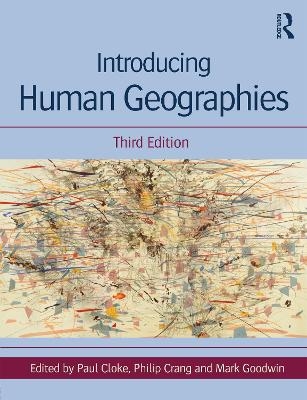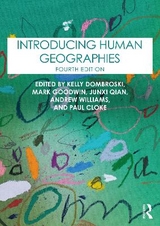
Introducing Human Geographies
Routledge (Verlag)
978-1-4441-3535-0 (ISBN)
Introducing Human Geographies is the leading guide to human geography for undergraduate students, explaining new thinking on essential topics and discussing exciting developments in the field.
This new edition has been thoroughly revised and updated and coverage is extended with new sections devoted to biogeographies, cartographies, mobilities, non-representational geographies, population geographies, public geographies and securities. Presented in three parts with 60 contributions written by expert international researchers, this text addresses the central ideas through which human geographers understand and shape their subject. Part I: Foundations engages students with key ideas that define human geography’s subject matter and approaches, through critical analyses of dualisms such as local-global, society-space and human-nonhuman. Part II: Themes explores human geography’s main sub-disciplines, with sections devoted to biogeographies, cartographies, cultural geographies, development geographies, economic geographies, environmental geographies, historical geographies, political geographies, population geographies, social geographies, urban and rural geographies. Finally, Part III: Horizons assesses the latest research in innovative areas, from mobilities and securities to non-representational geographies.
This comprehensive, stimulating and cutting edge introduction to the field is richly illustrated throughout with full colour figures, maps and photos. These are available to download on the companion website, located at www.routledge.com/9781444135350.
Paul Cloke is Professor of Human Geography at the University of Exeter. Philip Crang is Professor of Cultural Geography at Royal Holloway, University of London. Mark Goodwin is Professor of Human Geography and Deputy Vice-Chancellor at the University of Exeter.
Part 1: Foundations 1. Local-global 2. Society-space 3. Human-non-human 4. Modern-postmodern 5. Self-other 6. Masculinity-femininity 7. Science-art 8. Explanation-understanding 9. Representation-reality Part 2: Themes Section 1. Biogeographies 10. Nature and Human Geography 11. Animals and Plants 12. Political Ecology Section 2. Cartography 13. Power of Maps 14. Geographical Information Systems 15. Counter Geographies Section 3. Cultural Geographies 16. Imaginative Geographies 17. Place 18. Landscape 19. Material Geographies Section 4. Development Geographies 20. Theories of Development 21. Rethinking Development 22. Survival and Resistance 23. Human Geographies of the Global South Section 5. Economic Geographies 24. Spaces of Production 25. Money and Finance 26. Consumption-reproduction 27. Commodities 28. Economic Globalization Section 6. Environmental Geographies 29. Global & Local Environmental Problems 30. Sustainability 31. Climate Change Section 7. Historical Geographies 32. Modernity & Modernization 33. Colonialism & Postcolonialism 34. Space, Memory & Identity Section 8. Political Geographies 35. Critical Geopolitics 36. War & Peace 37. Nationalism 38. Citizenship & Governance Section 9. Population Geographies 39. Age 40. Health and Well-being 41. Migrants and Refugees Section 10. Social Geographies 42. Identities 43. Identity and Difference: Dis/ability and Sexuality 44. Exclusion 45. Diasporas Section 11. Urban and Rural Geographies 46. Urban Forms 47. Urban Senses 48. Rurality Part 3: Horizons Section 12. Non-representational Geographies 49. Emotion 50. Affect 51. Performances Section 13. Mobilities 52. Mobilities: Politics, Practices, Places 53. Touring Mobilities 54. Virtual Mobilities Section 14. Securities 55. Risk/Fear/Surveillance 56. Resources 57. Securing Life: New hHzards and Biosecurity Section 15. Publics 58. How to Think about Public Space 59. Ethical Spaces
| Zusatzinfo | 17 Tables, color; 54 Line drawings, color; 232 Halftones, color; 284 Illustrations, color |
|---|---|
| Verlagsort | London |
| Sprache | englisch |
| Maße | 189 x 246 mm |
| Gewicht | 2314 g |
| Themenwelt | Naturwissenschaften ► Geowissenschaften ► Geografie / Kartografie |
| ISBN-10 | 1-4441-3535-X / 144413535X |
| ISBN-13 | 978-1-4441-3535-0 / 9781444135350 |
| Zustand | Neuware |
| Haben Sie eine Frage zum Produkt? |
aus dem Bereich



